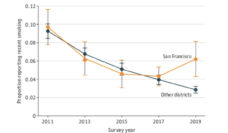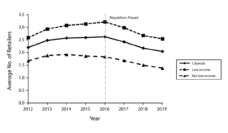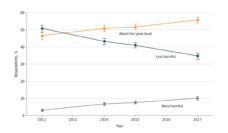Cigarette smoking in the U.S. has been steadily declining over the last fifty years. However, rural communities lag behind their urban counterparts. Compared to people living in cities, rural residents are more likely to smoke 15 or more cigarettes per day. Consequently, rates of smoking-related conditions such as heart disease, stroke, and lung cancer are higher in rural areas.
This widening urban-rural divide can be partially attributed to tobacco marketing and pricing strategies. Rural youth report viewing tobacco ads more frequently than urban youth across all media, including online, in convenience stores, and on TV.
Areas with predominately rural and low-income residents also tend to sell cheaper cigarettes, which can attract and retain smokers. For example, in the 1990s, a 40 cents reduction in Marlboro’s contributed to a 19% increase in smoking among youth. Tobacco coupons have also been shown to increase the risk of daily smoking among adults.
A team from The Ohio State University wanted to investigate how cigarette prices differed by neighborhood racial and economic characteristics in urban and rural areas. They analyzed cigarette prices from more than 200 licensed retailers in Ohio during summer 2016. Fieldworkers obtained the price of name-brand cigarette packs and the least expensive pack available. Prices were compared in rural and urban regions separately.
In rural Ohio, areas with high percentages of people living in poverty had the lowest-priced cigarettes. These cheap prices reduce the barriers for people to begin or continue smoking, thus contributing to higher smoking rates in rural and lower-income populations. The authors suggest three policy options to raise cigarette prices and reduce smoking behaviors: excise taxes, discount bans, and minimum-pricing laws.
The higher prices can deter people from buying cigarettes, and are particularly helpful for preventing smoking among youth.
Excise taxes impose an extra fee on consumers to purchase specific goods, such as tobacco products. The higher prices can deter people from buying cigarettes, and are particularly helpful for preventing smoking among youth. Cigarette taxes vary widely across the US. Consumers pay an additional $4.50 per cigarette pack in Washington D.C., compared to only $0.17 per pack in Missouri. Higher excise taxes can effectively discourage cigarette consumption while generating state revenue for tobacco prevention efforts.
Excise tax effectiveness is limited, however, by substantial product discounts. Tobacco industry discounts include “buy-one-get-one” offers and savings on multipacks. In 2016, tobacco companies spent $380 million on coupons alone, and $5.8 billion on reducing the prices of their products for consumers. Other countries, such as Canada and the UK, have banned coupons and promotional discounts. While the US lacks a national tobacco discount ban, individual states like New York have enacted legislation prohibiting tobacco coupons.
Minimum-pricing laws offer another option for counteracting tobacco discounts. These laws establish the lowest cost consumers pay for tobacco products and are especially effective at reducing smoking in lower-income households. About half of US states, and a handful of cities, have minimum-pricing laws for cigarettes. In Colorado, consumers pay at least $7 per pack, compared to $13 for those in New York City. However, for minimum-pricing laws to be effective, states will need to eliminate exemptions such as those that allow retailers to sell cigarettes at lower prices during a closeout clearance sale.
Together, excise taxes, discount bans, and minimum price laws can raise cigarette prices and reduce smoking rates. Economic policies, combined with other interventions like counseling and nicotine replacement therapy, can narrow the urban-rural divide in cigarette smoking rates to help rural communities save on medical costs and improve their long-term health outcomes.
Photo via Getty Images














